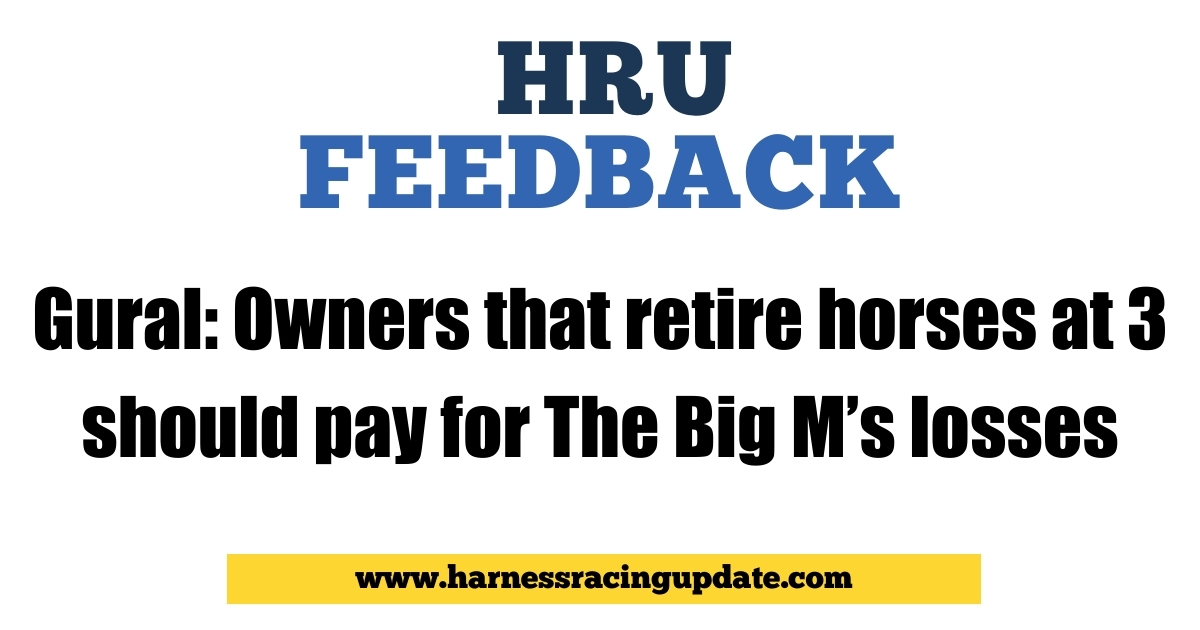Gural: Owners that retire horses at 3 should pay for The Big M’s losses
(In further response toDebbie Little’s Meadowlands Matters column “Money driving 3-year-olds to breeding shed, but is that good for the game?”)
I certainly understand the economics of retiring horses at 3 so as not to risk poor performance at 4, but maybe the fair thing is to have those people who are retiring these horses pick up the cost of the losses at The Meadowlands over the next few years while we wait to see if we can get a casino. I certainly would be willing to waive the Gural Rule for stallions that want to pick up the losses we are going to have because of the fact that our customers want to see great racing.
In addition, they can pick up the cost of getting us on TV since I think it cost us around $200,000 this year.
I own Six Pack and we raced him at 4 and it didn’t change any of the economics. One other thing, there is a great deal of enjoyment owning and racing a top 4-year-old and my guess is the money that the owners will receive from syndicating the horse will go right back into the business. The odds are they will buy three or four yearlings who could easily give the owners a significant amount of aggravation rather than fun. How do you put a price on the enjoyment that comes from watching a great horse race? Not only that, but you will not even know if the horse is going to be a good sire for four years. I doubt if I am going to change anyone’s mind but the argument for retiring horses at 3 ignores the upside that we had by racing Six Pack at 4.
Jeffrey Gural / owner The Meadowlands
More shoeless confusion
Two weeks ago, The Meadowlands hosted two nights of exciting, top-class harness racing, the Breeders Crown. Several years ago, I wrote about the shoes on/shoes off situation in harness racing. Other writers have written about this as well. A case in point would be Sig Sauer, a 3-year-old colt by Muscle Hill who is one of the favorites to win 3YO Trotter of the Year. In the Breeders Crown elimination race the week before, Oct. 19, I picked Sig Sauer to win on my USTA selections. He went off at 6-5 odds, followed cover and finished fourth, trotting his mile in 1:52. He’s a good-gaited trotter but he looked a bit unsteady in that race. His lackluster effort didn’t deter me and the next week, because I think he’s the best 3YO trotter in the sport. And, I figured that in the final, he’d be racing “without shoes.” In the $600,000 final, I picked Sig Sauer to win and made him 6-5 odds. Sig Sauer had post 8, left, took an early tuck sixth, and rallied gamely off cover to win by a nose at 7-2 odds while trotting in 1:50.4. He was a juicy overlay so I bet him to win.
As some may know, shoe changes are only announced at the track. In my opinion, if the sport is going to continue to allow shoe changes, the trainers should have to announce the change prior to the past performance programs being printed, so it can be listed in the past performances. In thoroughbred racing, the biggest equipment change is “blinkers on.” I’ve literally seen hundreds of horses improve so much in blinkers that they went from a horse that couldn’t break their maiden to a very solid professional racehorse with many wins. There are champion thoroughbreds that were average horses until they added blinkers. Blinkers on or blinkers off equipment changes have been listed in thoroughbred past performances for decades, even before I started following racing. In fact, blinkers are also listed in the entries that are published in newspapers. Obviously, the reason why thoroughbred racing started to put blinkers info in the program years ago was because it can be such a dramatic equipment change.
Well, shoes off on a trotter in harness racing might be even more potent of an equipment change than blinkers. Not every horse improves in blinkers, in fact, most don’t. But some horses improve by several seconds. With shoes off, many trotters seem to race their fastest miles.
It’s not fair to the betting public to wait until race day to announce these shoe changes at the track. Not everyone is a professional handicapper who has access to inside info. Most of the handle today is bet off track, mainly online. I’m sure that the reason why Sig Sauer didn’t go off as the favorite was because of his lackluster effort in his elimination race, when he was racing with shoes. Sudden form changes are bad for the sport. We shouldn’t be trying to confuse the bettors, or hide important handicapping information from them.
Shoes on or shoes off should be listed in the past performances. If the trainers can’t accommodate this, then all of the horses should have to race with shoes.
Bob Pandolfo / Northhampton, PA

















